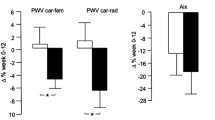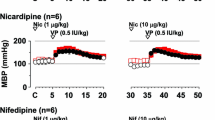Summary
The interference by nicardipine and verapamil with the response to vasoactive stimuli, such as lower body negative pressure and angiotensin II, has been evaluated in the forearm of hypertensive patients. Forearm blood flow was monitored during the intraarterial infusion of either drug at rates equieffective on basal flow. Nicardipine blunted the peak forearm vasoconstrictor action of lower body negative pressure and a comparable result was obtained when angiotensin II was administered intraarterially. In spite of a comparable increase in forearm flow, nicardipine was more potent than verapamil in inhibiting vasoconstriction following both stimuli. Thus, nicardipine suppressed regional vascular reactivity, probably by blockade of the influx of extracellular calcium, in response to receptor activation, since both alpha-adrenergic and angiotensin II receptor-mediated vasoconstrictor responses were attenuated. However, the results of the comparison with an unrelated calcium entry blocker, such as verapamil, may suggest that nicardipine, and possibly other dihydropiridine derivatives, preferentially antagonize agonist-mediated vasoconstriction in the human forearm.
Similar content being viewed by others
References
Pedrinelli R, Taddei S, Salvetti A (1989) Calcium entry blockade and alpha-adrenergic vascular reactivity in human beings: differences between nicardipine and verapamil. Clin Pharmacol Ther 45: 285–290
Langer SZ, Massingham R, Shepperson NB (1980) Presence of postsynaptic alpha-2 receptors of predominantly extrasynaptic location in the vascular smooth muscle of the dog hindlimb. Clin Sci 59: 225s-228s
Warnock P, Docherty JR (1986) Further investigation of the sites of vascular alpha-1 and alpha-2 adrenoceptors in the anesthetized spontaneously hypertensive rat. J Cardiovasc Pharmacol 8: 67–70
Sundlof G, Wallin BG (1982) Effect of lower body negative pressure on human muscle nerve sympathetic activity. J Physiol 278: 141–145
Taddei S, Salvetti A, Pedrinelli R (1989) Persistence of sympathetic-mediated forearm vasoconstriction after alpha-blockade in hypertensive patients. Circulation 80: 485–490
Pedrinelli R, Taddei S, Graziadei L, Salvetti A (1986) Vascular responses to ouabain and norepinephrine in low and normal renin hypertension. Hypertension 8: 786–792
Pedrinelli R, Bruschi G, Graziadei L, Taddei S, Panarace G, Orlandini G, Natali A, Borghetti A, Salvetti A (1988) Dietary sodium change in primary aldosteronism: atrial natriuretic factor, hormonal and vascular responses. Hypertension 12: 192–198
Zimmerman BG (1981) Adrenergic facilitation by angiotensin II: does it serve a physiologic function. Clin Sci 60: 343–348
Taddei S, Pedrinelli R, Salvetti A (1990) Indenolo, a beta-blocker with partial angonism at vascular beta-adrenoceptors. Clin Pharmacol Ther 46: 560–565
Ferguson DW, Dorsey KJ (1985) Effects of nifedipine on barore-flex modulation of vascular resistance in man. Am Heart J 109: 55–62
Benjamin N, Collier JG, Webb DJ (1988) Angiotensin II aug ments sympathetically-induced venoconstriction in man. Clin Sci 75: 337–340
Nelson MT, Standen NB, Brayden JE, Worley JF (1988) Noradrenaline contracts arteries by activating voltage-dependent calcium channels. Nature 336: 382–385
Taylor CW, Merritt JE (1986) Receptor coupling to polyphos phoinositide turnover: A parallel with adenylate cyclase system. Trends Pharmacol Sci 7: 238–242
Griendling KK, Tsuda T, Berk BC, Alexander RW (1989) Angiotensin II stimulation of vascular smooth muscle cells. Secondary signalling mechanisms. Am J Hypertens 2: 659–665
Taddei S, Salvetti A, Pedrinelli F (1988) Further evidence for the existence of alpha-2 mediated adrenergic vasoconstriction in human vessels. Eur J Clin Pharmacol 34: 407–411
Pedrinelli R, Panarace G, Salvetti A (1990) Calcium entry blockade and adrenergic vascular reactivity in hypertensives: differences between nicardipine and diltiazem. Clin Pharmacol Ther (in press)
Ferguson DW, Hayes DW (1989) Nifedipine potentiates car diopulmonary baroreflex control of sympathetic nerve activity in healthy humans. Circulation 80: 285–298
Bristow JD, Honour AJ, Pickering GW, Sleight P, Smyth HS (1969) Diminished baroreflex sensitivity in high blood pressure. Circulation 39: 48–54
Ferguson DW, Abboud FM, Mark AL (1984) Selective impairment of baroreflex-mediated vasoconstrictor responses in patients with ventricular dysfunction. Circulation 69: 451–460
Author information
Authors and Affiliations
Additional information
Presented in part at the 89th Meeting of the American Society for Clinical Pharmacology and Therapeutics, San Diego, CA, 9–11th March 1988
Rights and permissions
About this article
Cite this article
Pedrinelli, R., Taddei, S., Panarace, G. et al. Calcium entry blockade and agonist-mediated forearm vasoconstriction in hypertensive patients. Difference between nicardipine and verapamil. Eur J Clin Pharmacol 40, 1–5 (1991). https://doi.org/10.1007/BF00315131
Received:
Accepted:
Issue Date:
DOI: https://doi.org/10.1007/BF00315131




